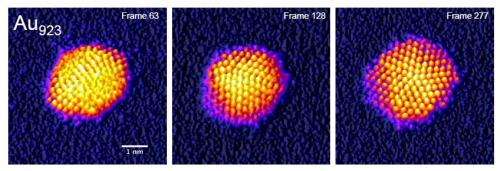Atomic structure of nanoparticles brought under control

Nanotechnologists are control freaks. They want to exploit the properties of materials at the ultimate level - the atoms.
Imagine the frustration therefore when you build a near million dollar machine to create beams of nanoparticles, each containing a precisely selected number of atoms, 923 say (a "magic number"), and then you find that you've made at least three different atomic architectures at the same time, like three flavours of ice cream. You want to find some way to transform all the flavours into one.
Wang and Palmer at the University of Birmingham, UK, (Physical Review Letters 108 245502, 2012) have found a solution to the challenge.
They use the superfine beam in the aberration-corrected electron microscope first to reveal the various 3-dimensional atomic arrangements - the "isomers" of their gold nanoclusters - and then, by prolonged illumination with the electron beam, they drive the particles one by one towards their most stable, equilibrium structures.
The result is a personalised video for each particle, showing the atoms on the move towards their atomic destinations - stable configurations like the decahedron.
Apart from satisfying the desire for control, the results provide a new reference for computational models of nanostructure dynamics, down to the atom scale.
More information: DOI: 10.1103/PhysRevLett.108.245502
Journal information: Physical Review Letters
Provided by University of Birmingham




















